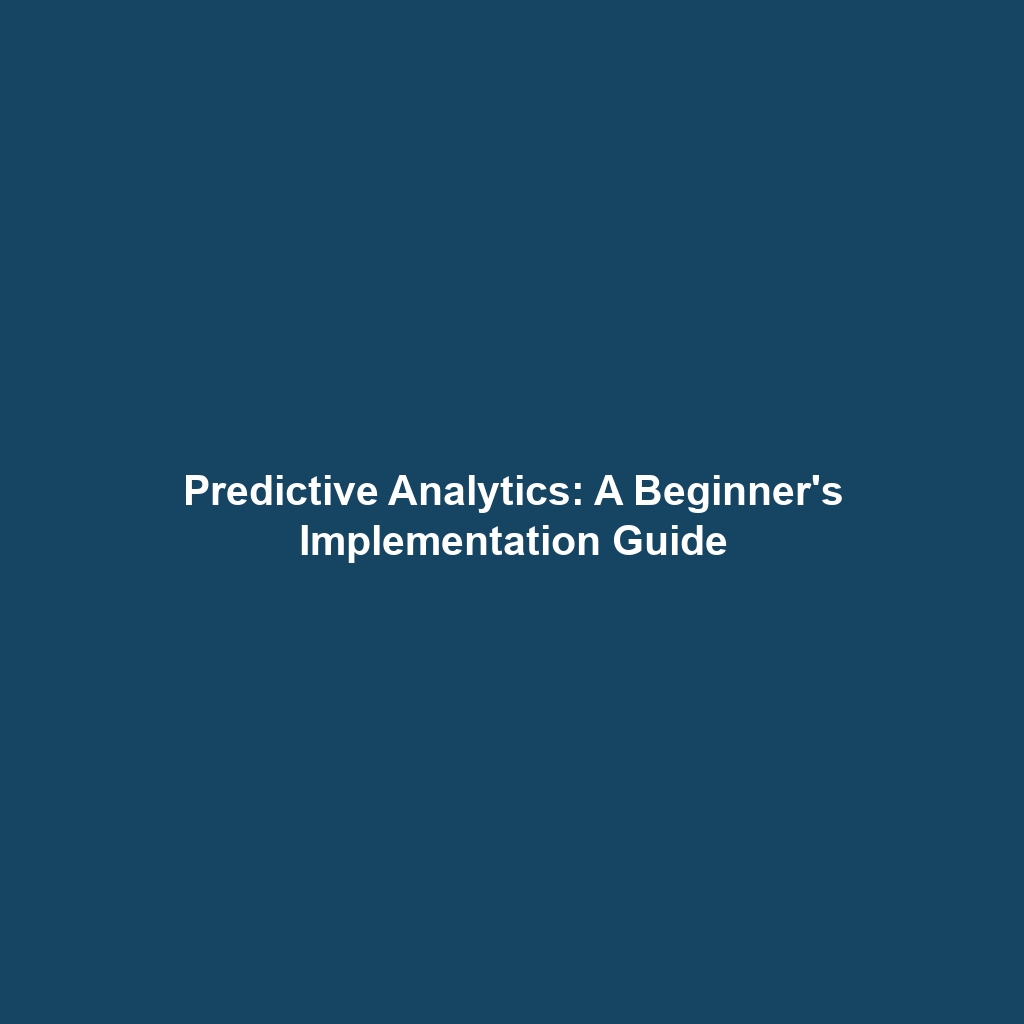Understanding the Power of Predictive Analytics
Predictive analytics uses statistical techniques, machine learning algorithms, and historical data to forecast future outcomes. Unlike traditional business intelligence, which focuses on what has happened, predictive analytics focuses on what will happen. This allows organizations to make more informed decisions, optimize processes, and gain a competitive edge.
Imagine a retail company struggling with inventory management. They often experience stockouts of popular items while simultaneously holding excess inventory of less popular products. Using predictive analytics, they can analyze historical sales data, seasonal trends, and external factors like weather forecasts to predict demand for each product with greater accuracy. This enables them to optimize inventory levels, reducing both stockouts and carrying costs. This is just one example of where predictive analytics can make an impact.
Key Insight: Predictive analytics moves beyond simply describing the past; it anticipates the future, enabling proactive decision-making.
Benefits of Implementing Predictive Analytics
- Improved Decision-Making: Data-driven insights lead to more informed strategic choices.
- Enhanced Operational Efficiency: Optimize processes, resource allocation, and supply chain management.
- Increased Revenue: Identify new market opportunities, personalize customer experiences, and boost sales.
- Reduced Risk: Predict potential threats, mitigate fraud, and improve risk management.
- Competitive Advantage: Gain a deeper understanding of your customers and market trends to stay ahead of the competition.
Step-by-Step Guide to Implementing Predictive Analytics
Implementing predictive analytics can seem daunting, but by breaking it down into manageable steps, the process becomes much more approachable.
1. Define Your Business Objectives
Before you even think about data or models, clearly define what you want to achieve with predictive analytics. What specific business problems are you trying to solve? What questions do you want to answer? The more specific you are, the better you’ll be able to focus your efforts and measure your success.
For example, instead of saying “We want to improve sales,” try “We want to increase customer retention by 15% in the next quarter” or “We want to reduce customer churn by identifying customers at risk of leaving.” This level of specificity will guide your data collection and model building efforts. I’ve often seen projects fail because they started with the technology and then tried to find a problem to solve. The problem should always come first.
2. Data Collection and Preparation
Data is the lifeblood of predictive analytics. You need to collect relevant data from various sources, both internal and external. This might include:
- Internal Data: Sales records, customer data, marketing campaign data, operational data, financial data.
- External Data: Market research reports, industry trends, economic indicators, social media data, weather data.
Once you’ve collected the data, you need to clean and prepare it for analysis. This involves:
- Data Cleaning: Removing errors, inconsistencies, and duplicates.
- Data Transformation: Converting data into a suitable format for analysis (e.g., scaling, normalization).
- Feature Engineering: Creating new variables from existing ones to improve model performance.
This stage is often the most time-consuming, but it’s crucial for building accurate and reliable models. I once worked on a project where we spent 80% of our time just cleaning and preparing the data. It felt like a waste at the time, but the improvement in model accuracy was well worth the effort.
Key Insight: The quality of your data directly impacts the accuracy and reliability of your predictive models. Invest time and resources in data cleaning and preparation.
3. Model Building and Selection
Now it’s time to build your predictive models. There are many different algorithms to choose from, each with its strengths and weaknesses. Some popular options include:
- Linear Regression: For predicting continuous values (e.g., sales revenue).
- Logistic Regression: For predicting binary outcomes (e.g., customer churn).
- Decision Trees: For classification and regression tasks, easy to interpret.
- Random Forests: An ensemble of decision trees, often providing higher accuracy.
- Support Vector Machines (SVM): Effective for complex classification problems.
- Neural Networks: Powerful for complex patterns, but require large amounts of data and are often difficult to interpret.
The best algorithm for your specific use case will depend on the type of data you have, the complexity of the problem, and the desired level of accuracy. It’s often a good idea to try several different algorithms and compare their performance. Model selection involves balancing the accuracy of the model with its interpretability. A highly accurate but opaque model may be less useful than a slightly less accurate but easily understandable model.
4. Model Evaluation and Validation
Once you’ve built your models, you need to evaluate their performance. This involves using various metrics to assess how well the models are predicting the desired outcomes. Common metrics include:
- Accuracy: The percentage of correct predictions.
- Precision: The proportion of positive predictions that are actually correct.
- Recall: The proportion of actual positive cases that are correctly identified.
- F1-Score: A weighted average of precision and recall.
- RMSE (Root Mean Squared Error): A measure of the difference between predicted and actual values (for regression models).
It’s crucial to validate your models using a separate dataset that was not used for training. This helps to ensure that the models generalize well to new data and are not simply overfitting the training data. Overfitting is when a model learns the training data *too* well, including the noise and specific patterns that don’t generalize. It’s like memorizing the answers to a test instead of learning the material.
5. Model Deployment and Integration
After evaluating and validating your models, it’s time to deploy them into a production environment. This involves integrating the models with your existing systems and processes so that they can be used to generate predictions in real-time.
There are several ways to deploy predictive models, depending on your specific needs and infrastructure. Some common options include:
- API (Application Programming Interface): Exposing the model as a web service that can be accessed by other applications.
- Batch Processing: Running the model on large datasets on a scheduled basis.
- Embedded Deployment: Integrating the model directly into existing applications or systems.
Consider the resources and technical skillset of your team when choosing a deployment method. API deployments can be more complex but allow for real-time predictions. Batch processing is generally easier but only provides results periodically.
6. Model Monitoring and Maintenance
The work doesn’t end once the model is deployed. You need to continuously monitor its performance to ensure that it’s still accurate and reliable. Over time, the relationship between the input data and the predicted outcome may change, leading to model drift. Model drift can occur due to changes in customer behavior, market conditions, or data quality.
To mitigate model drift, you should:
- Track Key Performance Metrics: Monitor accuracy, precision, recall, and other relevant metrics.
- Regularly Retrain Models: Update the models with new data to keep them current.
- Implement Alerting Systems: Set up alerts to notify you when model performance drops below a certain threshold.
Model monitoring and maintenance are crucial for ensuring the long-term success of your predictive analytics initiatives. Think of it like regular maintenance on a car. Neglecting it will eventually lead to breakdowns.
Key Insight: Predictive models are not static; they require ongoing monitoring and maintenance to ensure continued accuracy and relevance.
Comparing Predictive Analytics Software Solutions
Choosing the right software solution is critical for successful predictive analytics implementation. There are numerous options available, each with its own strengths and weaknesses. Here’s a comparison of some popular solutions:
Open-Source Solutions
- R: A powerful programming language and environment for statistical computing and graphics. Excellent for custom model building but requires strong programming skills.
- Python: A versatile programming language with a rich ecosystem of libraries for data science and machine learning (e.g., scikit-learn, TensorFlow, PyTorch).
Pros: Free, highly customizable, large community support.
Cons: Requires strong programming skills, steeper learning curve.
Commercial Solutions
- SAS: A comprehensive analytics platform with a wide range of features for data management, statistical analysis, and machine learning.
- IBM SPSS: A user-friendly statistical software package with a graphical interface.
- Alteryx: A data blending and analytics platform that allows users to easily prepare, blend, and analyze data.
- Tableau: Primarily a data visualization tool, but it also has predictive analytics capabilities.
- DataRobot: An automated machine learning platform that simplifies the model building and deployment process.
- Amazon SageMaker: A fully managed machine learning service that enables you to build, train, and deploy machine learning models quickly.
- Microsoft Azure Machine Learning: A cloud-based machine learning platform that offers a variety of tools and services for building and deploying models.
- Google Cloud AI Platform: A comprehensive platform for building, deploying, and managing machine learning models on Google Cloud.
Pros: User-friendly interfaces, comprehensive features, dedicated support.
Cons: Can be expensive, less flexible than open-source solutions.
When choosing a software solution, consider your budget, technical expertise, and specific business requirements. Don’t be afraid to try out free trials or demos before making a decision. Many cloud-based services offer free tiers or credits for experimentation.
Best Practices for Data Governance
Data governance is a critical aspect of any predictive analytics initiative. It ensures that data is accurate, consistent, and reliable. Poor data governance can lead to inaccurate models, flawed insights, and ultimately, bad decisions.
Here are some best practices for data governance:
- Establish Data Ownership: Assign responsibility for data quality and accuracy to specific individuals or teams.
- Define Data Standards: Establish clear standards for data formats, naming conventions, and data validation rules.
- Implement Data Quality Controls: Implement automated checks and manual reviews to identify and correct data errors.
- Ensure Data Security and Privacy: Protect sensitive data from unauthorized access and comply with relevant regulations (e.g., GDPR, CCPA).
- Document Data Lineage: Track the origin and transformation of data to understand its provenance and ensure traceability.
Data governance is an ongoing process, not a one-time effort. It requires a commitment from all stakeholders within the organization. Strong data governance builds trust in the data and in the insights derived from it.
Key Insight: Effective data governance is essential for ensuring the quality, reliability, and security of your data, which directly impacts the success of your predictive analytics initiatives.
Building a Data-Driven Culture
Implementing predictive analytics is not just about technology; it’s also about culture. To truly leverage the power of predictive insights, you need to foster a data-driven culture within your organization. This means encouraging everyone to embrace data as a valuable asset and to use data to inform their decisions.
Here are some tips for building a data-driven culture:
- Provide Training and Education: Equip employees with the skills and knowledge they need to understand and use data effectively.
- Promote Data Literacy: Encourage employees to develop their data literacy skills, including the ability to interpret data, identify trends, and draw conclusions.
- Make Data Accessible: Provide easy access to data and analytics tools for all employees who need them.
- Encourage Experimentation: Create a safe environment for experimentation and learning from failures.
- Celebrate Successes: Recognize and reward employees who use data to achieve positive results.
Changing an organization’s culture takes time and effort, but it’s well worth the investment. A data-driven culture empowers employees to make better decisions, solve problems more effectively, and drive innovation.
I’ve seen organizations transform from relying on gut feelings to making decisions based on data, and the results have been remarkable. But it requires leadership buy-in and a willingness to change. One technique that I’ve found helpful is to start with small, quick wins. Show people the power of data by solving a small, easily solvable problem. Once they see the results, they’re more likely to embrace data-driven decision-making.
Conclusion
Implementing predictive analytics can be a transformative experience for your organization. By following the steps outlined in this guide, you can unlock the power of AI-powered foresight and gain a significant competitive advantage. Remember to start with clear business objectives, focus on data quality, choose the right software solution, and build a data-driven culture.
The future belongs to those who can anticipate it. Predictive analytics empowers you to see the future more clearly and make the decisions needed to thrive in a rapidly changing world. Consider how advanced analytics can help your business evolve with strategic foresight and a data-driven approach. Don’t just react to the present; shape your future with predictive insights.
This article was optimized and published by Content Hurricane.


